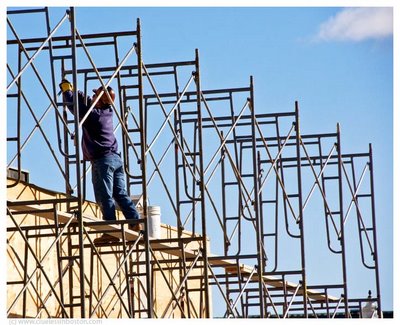The Benefits of Scaffolding for Safety and Performance in Structure Projects
Scaffolding is a crucial part in the world of building, substantially contributing to both security and operational performance. The influence of scaffolding prolongs past fundamental security measures; its tactical application can transform job timelines and results (Scaffolding).
Enhanced Employee Safety And Security

Improved worker safety is a critical worry in the construction sector, where the risks linked with drops and accidents can have alarming consequences. Effective scaffolding systems play a critical function in reducing these dangers by giving stable platforms for workers at raised elevations. By ensuring that scaffolding is correctly erected and kept, building companies can dramatically minimize the likelihood of drops, which are amongst the leading sources of work environment injuries and deaths.
Additionally, scaffolding improves safety with its design functions. Guardrails, toe boards, and non-slip surfaces add to a secure working setting, minimizing the threat of crashes. In addition, scaffolding enables workers to accessibility hard-to-reach locations without the need for makeshift remedies, which can endanger security requirements.
Training employees on the appropriate use scaffolding is equally vital. Making certain that employees are experienced regarding lots abilities, setting up procedures, and safety methods further improves the effectiveness of scaffolding in avoiding mishaps. To conclude, incorporating robust scaffolding systems within building and construction jobs not just enhances employee safety and security however also advertises a culture of safety that profits the whole labor force while enhancing general efficiency.
Improved Accessibility and Mobility

Moreover, scaffolding enables for the convenient transportation of devices and products, reducing downtime connected with moving devices. Workers can effectively access various areas of a project, which is particularly essential in complicated builds where upright and straight motion is regular - Scaffolding. This accessibility not only simplifies operations but likewise enables groups to react rapidly to altering project needs
Additionally, scaffolding can be customized to accommodate particular website problems, improving wheelchair in limited or uneven rooms. This versatility makes sure that construction tasks can continue efficiently, no matter the obstacles provided by the setting. By cultivating better accessibility and movement, scaffolding plays a vital role in sustaining construction crews and enhancing the overall efficiency of structure projects.
Boosted Project Efficiency
In building and construction, job effectiveness is substantially influenced by the reliable use scaffolding systems. By providing a steady and secure platform for employees, scaffolding minimizes downtime and speeds up the speed of building and construction tasks. With improved access to elevated workplace, groups can finish jobs quicker, minimizing the general project timeline.
The modular nature of modern scaffolding permits for rapid setting up and disassembly, enabling swift shifts in between different phases of a job. This versatility not just enhances process but also adds to far better control among different trades, as numerous groups can function at the same time on various areas of a structure.
Moreover, scaffolding makes sure that workers are located correctly to do their tasks without unneeded stress or risk of injury, consequently lowering the likelihood of mishaps that can bring about pricey delays. Improved security actions installed in scaffolding systems, such as guardrails and toe boards, further support effective operations by maintaining employee concentrate on the job at hand instead of security concerns.

Adaptability for Numerous Tasks
Scaffolding systems attract attention for their versatility across a large range of building tasks, capable of conference particular website needs and tasks. Their modular style permits quick changes to accommodate different building types, from residential to commercial structures, guaranteeing that workers have secure gain access to at different elevations and angles.
These systems can be customized for varied applications, such as frontage job, interior improvements, or heavy-duty commercial tasks. For circumstances, light-weight aluminum scaffolds are suitable for interior work, while durable steel frameworks supply the essential support for large-scale building and construction. The adaptability of scaffolding includes its capability to be set up for both temporary and permanent frameworks, enabling contractors to efficiently plan article source and implement their tasks.
Additionally, scaffolding can be utilized in difficult settings, consisting of metropolitan setups where room is minimal or on irregular terrain where standard access options are not practical. This flexibility minimizes the need for several accessibility remedies, minimizing prices and job timelines. By accommodating a selection of conditions and tasks, scaffolding enhances the overall effectiveness and performance of building and construction initiatives, proving to be a crucial property in the building industry.
Conformity With Safety And Security Criteria
Just how can construction projects make certain the safety of employees while maintaining performance? Governing frameworks, such as OSHA in the United States, offer standards that regulate the use of scaffolding, making sure that it meets rigorous safety requirements.
Proper scaffolding design and installation play an important role in compliance. Educating employees on secure scaffold usage and the relevance of conformity with safety and security requirements even more reinforces a society of safety and security on-site.
In addition, documents and record-keeping associated to safety and security assessments and employee training are essential. These methods not only show conformity but likewise provide liability and transparency. Ultimately, by prioritizing adherence to safety and security criteria, construction jobs can foster a much safer workplace, thus raising productivity and effectiveness without endangering employee safety and security.
Conclusion
In final thought, scaffolding serves as an essential element in building jobs, significantly boosting safety and effectiveness. Adherence to safety and security requirements underscores the significance of scaffolding in achieving effective project outcomes, making it essential in the building and construction market.
Scaffolding is an essential component in the world of construction, dramatically contributing to both safety and security and functional effectiveness. The effect of scaffolding expands past basic security actions; its tactical implementation can change job timelines and results. In conclusion, integrating robust scaffolding systems within building jobs not just improves worker security however additionally advertises a culture learn this here now of security that benefits the whole workforce while enhancing total efficiency.
In verdict, scaffolding offers as try this website an important component in structure projects, significantly improving security and effectiveness. Adherence to security requirements highlights the relevance of scaffolding in achieving successful task results, making it essential in the building sector.